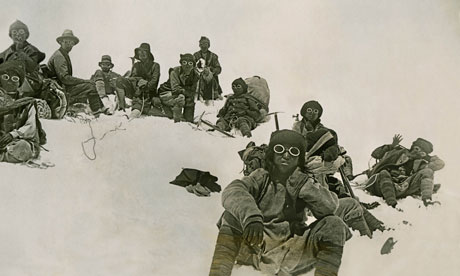At the moment we are reading a great book, called Into The Silence, by Wade Davis, about the first Europeans to see Mount Everest, their attempts to climb it and the ill-fated attempt by George Mallory for the summit. All of the mountaineering is set against a backdrop of the First World War and England’s relationship with Tibet, especially as the British Empire began to unravel after the Great War.
One of the main themes of the book, is the extraordinary physical efforts that it took to access the Himalaya mountain range, measure, survey and map the vast area and discover and measure a mountain which would later be come known as Everest.
Even getting to the point where Everest was observed for the first time, from many miles away, took a huge team of British explorers, scientists and soldiers, along with a plethora local guides and porters, months of arduous trekking, climbing and, in some cases, fighting with local tribes, to even get to the foothills. This was exploration in the true sense, trying to access an area that was completely unknown, unmapped and hostile. That is before the mountain was climbed.
Everest – then and now
Back in the late 1800’s and early 1900s, getting to and climbing Everest was much, much harder than it is today. There were no maps. There were few, if any, paths or tracks to follow, let alone roads. The process of communicating with local and national political bodies in Tibet was extremely challenging making obtaining permission to cross the Himalaya and attempt a climb time consuming and frustrating. Kit was extremely low tech, making the challenge of getting to Everest and then climbing it much, much more dangerous and uncomfortable.
Now you can fly closer than ever to the Himalayas and then be ‘helecoptered’ in to base camp, where you will be greeted by a tent-city with all the creature comforts you can imagine. There you will find maps and charts and schedules as well as GPS devices and satellite feeds with up-to-the-second weather reports. On the climb itself, in your modern climbing kit, you will be warmer and drier and more comfortable than those early pioneers could ever imagine. And you can use oxygen and pre-laid ladders for the climb itself.
All of this means, that provided you have the money, you have a much better chance of reaching the top of the world than ever before. In fact whilst climbing Everest is undoubtedly one of the most adventurous things you can do, there are many people alive who have done what you have done and the exclusive group you have joined is getting less and less exclusive by the year. If you want people to be really impressed, you need to make your climb part of something bigger or include an extra element that is really impressive. You need to do more to stand out.
That is why people are climbing all of the 8000s (i.e. climbing each of the eight mountains on earth over 8000m) or the highest peak on each continent, or being the first whatever to have climbed Everest, or the first to have climber the world’s highest peak in a chicken costume (that last one might have been made up).
What has all this got to do with marketing and social networks?
As it is easier to climb Everest, so it is with marketing: the similarities between climbing Everest and marketing your business are striking.
Back in the early days of marketing those with the resources, toughness and experience had the best chance of reaching the top and getting themselves heard. Those people who chose to be marketeers (read, mountaineers) were heroes – great men (it was, sadly, usually men) with great ambitions, great ideas and great personalities.
It took a massive effort and budget to get to the media you needed in order to spread your message. Your assault team would be a veritable army – designers, photographers and artists to create print or outdoor advertising. Producers, actors and animators for radio, cinema or TV adverts. You even needed a corps of specialists to plan and buy your media for you. Your audience – the mountain you were aiming for – was hard to access and even harder to scale.
But now the barriers are falling. Social networks are like a super-highway to the foot of the mountain. You no longer need vast budgets to reach the foot of the mountain that you need to climb to communicate with your audience.
Sure, the climb itself will be tough: you still need to have a great product and a clear message. You still need to think on your feet, be consistent and be creative. But as with today’s mountaineers, the technology is there to help you. Social networks are constantly accessible. It is possible to see something, take a photo and post it to your social outlets in a minute with nothing more than a smartphone.
Busy mountain, busy social networks

So reaching the top has never been easier. Unfortunately that also means there are many more people trying it, so the lower slopes are much, much busier – just like on Everest today. But if you are determined and work hard, then you can get above the crowd and reach the summit and beyond.
Whilst the barriers to reaching the top are fewer, you might decide that you need a team of Sherpas to help get you there – people who know and love the mountain – and in that case, freestak is ready and waiting. Just drop us a line at info@freestak.com because we would love to find out more about your expedition. We look forward to going climbing together.

Leave a Comment